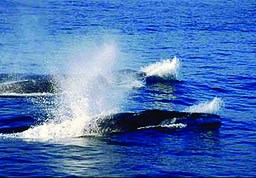
NOAA Photo / J. Waite Balaenoptera physalusBasic FactsThe fin whale is a member of the Mysticete (mustached) suborder of whales. The second largest whale on the planet, fin whales reach 70 to 80 feet in length and weigh 40 to 80 tons. Fin whales have a distinctive V-shaped pattern of coloration around their head called a “chevron.” Although the overall visible color of the animal is dark gray, the right side of the head, upper lip, lower lip, and a portion of the baleen are white. They sometimes have dark ear and eye stripes in a pattern that is called a “blaze.” The dorsal fin of the whale is also distinct. Researchers classify dorsal fins into one of six different shapes and this, along with scaring, chevron and blaze patterns, is what they use to identify individuals. A fin whale’s flukes are broad and triangular, and its head is pointed. Called the “greyhound of the sea,” the sleek, muscular fin whale swims at speeds up to 20 miles per hour. Upon surfacing, the fin whale lets go a blow 18 to 20 feet high. From a distance it might be mistaken for a humpback whale, but the length between the blow and the dorsal fin is much greater for the fin whale. The fin whale rarely shows its flukes when diving. Habitat, Range and Local SightingsFin whales are found in all the world’s oceans, but tend to stay in deep water. Fjords provide the right environment for spotting fin whales. In Kenai Fjords, we tend to see fin whales just two or three times a season, usually quite early (May) and again much later in the season (August). The area between the end of the Resurrection Peninsula and Cheval Island and on over towards Agnes Cove is the best place in the park to spot a fin whale. Food and Survival StrategiesThe fin whale is a filter feeder with 500 to 900, three-foot-long baleen plates hanging from the roof of its mouth and 64 ventral throat grooves allowing for expansion of the mouth. The plates and throat grooves enable the whale to take in huge quantities of water laden with prey and then strain out the food. Eastern north Pacific fin whales spend the summer months feeding in the waters of Alaska. They eat euphasiids (krill), copepods, and small schooling fish like herring and capelin. Fin whales have no tight social organization but sometimes travel in groups of 2-10, employing a circling technique to corral a school of fish before gulping a large mouth full of water filled with food. Reproduction and YoungFin whales found in Alaska during the summer spend their winters off of Mexico, where they breed and give birth. Gestation lasts a full year, and females give birth only once every two years. A calf weighs about four tons and is 22 feet long at birth. Young whales nurse for six to seven months and leave their mothers soon after this time. Sexual maturity is reached by age six for males and seven for females. It is quite possible that fin whales live to be 100 years of age. Transient orca whales may prey on young fin whales. There have been several incidents recorded of young fin whales stranding but exact cause of death in these cases is unknown. Human ConnectionsWhen the blue whale population became depleted from hunting, attention turned toward the fin whale. The fin whale was faster than most whaling boats in the early days but as technology improved, the whalers could keep up. Between 1950 and 1960, about 30,000 fin whales were taken each year. In 1972, the Marine Mammal Protection Act kept fin whales in U.S. waters safe, but it wasn’t until 1986 that fin whales were protected worldwide. |
Last updated: March 15, 2018
